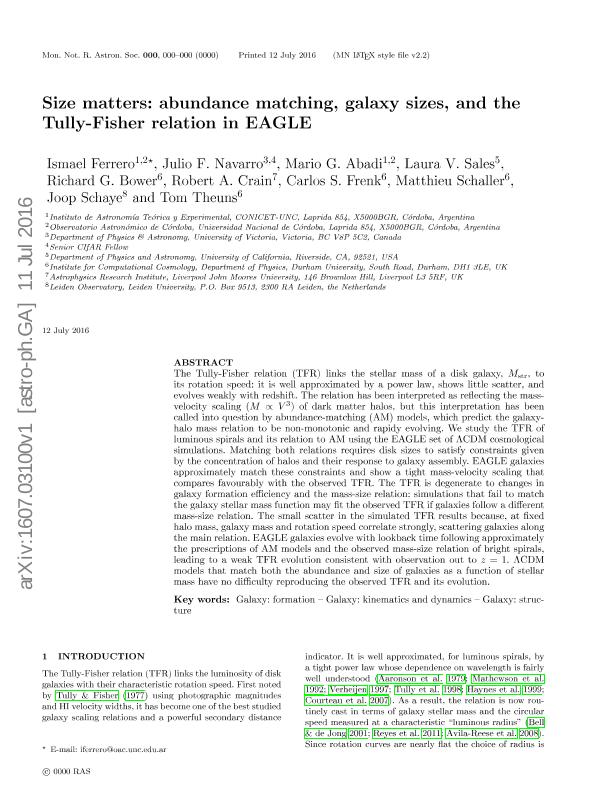Mostrar el registro sencillo del ítem
dc.contributor.author
Ferrero, Santiago Ismael

dc.contributor.author
Navarro, Julio F.

dc.contributor.author
Abadi, Mario Gabriel

dc.contributor.author
Sales, Laura Virginia

dc.contributor.author
Bower, Richard
dc.contributor.author
Crain, Robert A.
dc.contributor.author
Frenk, Carlos S.
dc.contributor.author
Schaller, Matthieu
dc.contributor.author
Schaye, Joop
dc.contributor.author
Theuns, Tom
dc.date.available
2018-11-22T19:01:29Z
dc.date.issued
2017-02
dc.identifier.citation
Ferrero, Santiago Ismael; Navarro, Julio F.; Abadi, Mario Gabriel; Sales, Laura Virginia; Bower, Richard; et al.; Size matters: Abundance matching, galaxy sizes, and the Tully-Fisher relation in EAGLE; Wiley Blackwell Publishing, Inc; Monthly Notices of the Royal Astronomical Society; 464; 4; 2-2017; 4736-4746
dc.identifier.issn
0035-8711
dc.identifier.uri
http://hdl.handle.net/11336/64946
dc.description.abstract
The Tully-Fisher relation (TFR) links the stellar mass of a disc galaxy, Mstr, to its rotation speed: it is well approximated by a power law, shows little scatter, and evolves weakly with redshift. The relation has been interpreted as reflecting the mass-velocity scaling (M ∝ V3) of dark matter haloes, but this interpretation has been called into question by abundance-matching (AM) models, which predict the galaxy-halo mass relation to deviate substantially from a single power law and to evolve rapidly with redshift. We study the TFR of luminous spirals and its relation to AM using the EAGLE set of Λ cold dark matter (ΛCDM) cosmological simulations. Matching both relations requires disc sizes to satisfy constraints given by the concentration of haloes and their response to galaxy assembly. EAGLE galaxies approximately match these constraints and show a tight mass-velocity scaling that compares favourably with the observed TFR. The TFR is degenerate to changes in galaxy formation efficiency and the mass-size relation; simulations that fail to match the galaxy stellar mass function may fit the observed TFR if galaxies follow a different mass-size relation. The small scatter in the simulated TFR results because, at fixed halo mass, galaxy mass and rotation speed correlate strongly, scattering galaxies along the main relation. EAGLE galaxies evolve with lookback time following approximately the prescriptions of AM models and the observed mass-size relation of bright spirals, leading to a weak TFR evolution consistent with observation out to z = 1. ΛCDM models that match both the abundance and size of galaxies as a function of stellar mass have no difficulty reproducing the observed TFR and its evolution.
dc.format
application/pdf
dc.language.iso
eng
dc.publisher
Wiley Blackwell Publishing, Inc

dc.rights
info:eu-repo/semantics/openAccess
dc.rights.uri
https://creativecommons.org/licenses/by-nc-sa/2.5/ar/
dc.subject
Galaxy: Formation
dc.subject
Galaxy: Kinematics And Dynamics
dc.subject
Galaxy: Structure
dc.subject.classification
Astronomía

dc.subject.classification
Ciencias Físicas

dc.subject.classification
CIENCIAS NATURALES Y EXACTAS

dc.title
Size matters: Abundance matching, galaxy sizes, and the Tully-Fisher relation in EAGLE
dc.type
info:eu-repo/semantics/article
dc.type
info:ar-repo/semantics/artículo
dc.type
info:eu-repo/semantics/publishedVersion
dc.date.updated
2018-10-22T13:04:26Z
dc.identifier.eissn
1365-2966
dc.journal.volume
464
dc.journal.number
4
dc.journal.pagination
4736-4746
dc.journal.pais
Reino Unido

dc.journal.ciudad
Londres
dc.description.fil
Fil: Ferrero, Santiago Ismael. Consejo Nacional de Investigaciones Científicas y Técnicas. Centro Científico Tecnológico Conicet - Córdoba. Instituto de Astronomía Teórica y Experimental. Universidad Nacional de Córdoba. Observatorio Astronómico de Córdoba. Instituto de Astronomía Teórica y Experimental; Argentina. Universidad Nacional de Córdoba. Observatorio Astronómico de Córdoba; Argentina
dc.description.fil
Fil: Navarro, Julio F.. University Of Victoria; Canadá
dc.description.fil
Fil: Abadi, Mario Gabriel. Consejo Nacional de Investigaciones Científicas y Técnicas. Centro Científico Tecnológico Conicet - Córdoba. Instituto de Astronomía Teórica y Experimental. Universidad Nacional de Córdoba. Observatorio Astronómico de Córdoba. Instituto de Astronomía Teórica y Experimental; Argentina. Universidad Nacional de Córdoba. Observatorio Astronómico de Córdoba; Argentina
dc.description.fil
Fil: Sales, Laura Virginia. University of California; Estados Unidos
dc.description.fil
Fil: Bower, Richard. University of Durham; Reino Unido
dc.description.fil
Fil: Crain, Robert A.. Liverpool John Moores University; Reino Unido
dc.description.fil
Fil: Frenk, Carlos S.. University of Durham; Reino Unido
dc.description.fil
Fil: Schaller, Matthieu. University of Durham; Reino Unido
dc.description.fil
Fil: Schaye, Joop. Leiden University; Países Bajos
dc.description.fil
Fil: Theuns, Tom. University of Durham; Reino Unido
dc.journal.title
Monthly Notices of the Royal Astronomical Society

dc.relation.isreferencedin
info:eu-repo/semantics/reference/doi/10.1093/mnras/stw2691
dc.relation.alternativeid
info:eu-repo/semantics/altIdentifier/url/https://academic.oup.com/mnras/article-abstract/464/4/4736/2417418/Size-matters-abundance-matching-galaxy-sizes-and?redirectedFrom=fulltext
dc.relation.alternativeid
info:eu-repo/semantics/altIdentifier/doi/https://dx.doi.org/10.1093/mnras/stw2691
Archivos asociados
